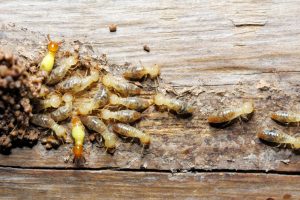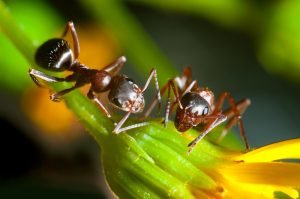
Brown Marmorated Stink Bug (Halyomorpha halys) on white background
After a long winter, it may seem like spring’s arrival has come at a crawling pace. March marks the official beginning of spring, as well as the unofficial launch of pest season. As temperatures warm up and moisture peaks, insects come creeping.
Just as different flowers bloom in the spring versus the summer, there is a seasonality to bugs. You’re more likely to see different species at certain times of the year, and spring pests are not for the faint-hearted.
We’ve rounded up the four most common insects that might frequent your home this spring and provide a few tips for preventing them.
1. Brown Marmorated Stink Bug: Now that temperatures are beginning to rise, you may notice an increased presence of the brown marmorated stink bug in your home. It’s likely that these sightings are actually stink bugs that wintered in your home and are now reemerging. Stink bugs feed on fruits, vegetables, tree leaves, and weeds. They rightfully earned their name because, when they are squashed or frightened, they emit a foul odor. Once you have stink bugs in your home, it can be extremely difficult to get rid of them.

Closeup worker and soldier termites (Globitermes sulphureus) on wood structure
2. Termites: Termites are ancestrally linked to cockroaches. Termites eat wood, and if they choose your home as a food source, they can cause significant and costly structural damage. Termites swarm when they’re mating —meaning they fly and breed in large numbers. This mating technique is used to help spread and establish new colonies. For a swarm to occur, the weather has to be warm, and swarming typically follows a rain. If you see termites swarming in your home, it’s likely you have an infestation.
3. Cockroaches: Four types of cockroaches typically are found in Ohio: German, American, Oriental, and Brown-banded. Cockroaches are most active at night and are social insects, living in groups. Figuring out what kind of cockroach is in your home can help you know how eliminate them. Oriental cockroaches are commonly found in basements because they like cooler conditions. German and American cockroaches usually frequent kitchens and bathrooms. Brown-banded cockroaches require less water so can be found all over your house. All types of cockroaches are attracted to food and water sources in your home and can carry bacteria.
4. Carpenter Ants: Carpenter ants are the largest variety of ants in the United States, with winged queens measuring up to three-quarters of an inch. They eat plant and animal matter and forage for food up to 100 feet from their nests. They nest in wooden structures and are most commonly found in water-damaged spaces in and near window and door frames, dishwashers, chimneys, drain gutters, wooden shingles, and porches.
Increased rain and warmer temperatures in the spring create an ideal environment for most of these pests to colonize in your home or other structures on your property. There is action you can take to help prevent your home from becoming a nesting site.

Two ants are working on yellow flower. Macro view. Close-up photography
Prevention:
- Eliminate food sources and keep rooms clean and dry—especially kitchens.
- Do not store paper bags, magazines, cardboard containers, stacks of clothes and other materials that provide dark shelter in your kitchen, basement, or near points of entry to your home.
- Seal any crevices or holes around pipes and conduits into and out of the home and repair cracks in the floors and walls.
- Repair any leaks and keep floors and surfaces dry.
- Ensure vents to the outside of the house have proper covers that are securely attached.
The sooner insects are detected and removed from your home, the less damage they can cause. If you suspect you have an insect problem in your home, call A-1 Able Pest Doc today to schedule a thorough inspection.
SOURCES:
https://www.usatoday.com/story/news/nation/2015/04/03/stink-bug-season-get-rid/25273925/
http://extension.umd.edu/hgic/topics/termites

Recent Comments